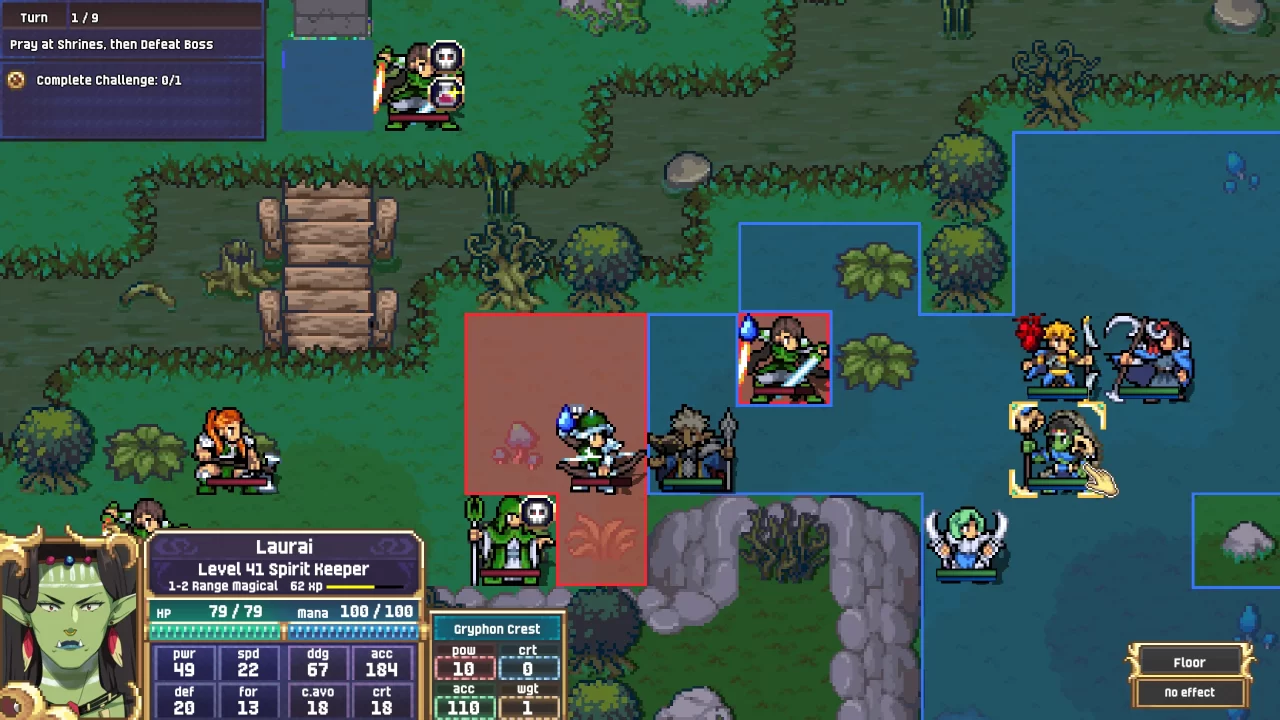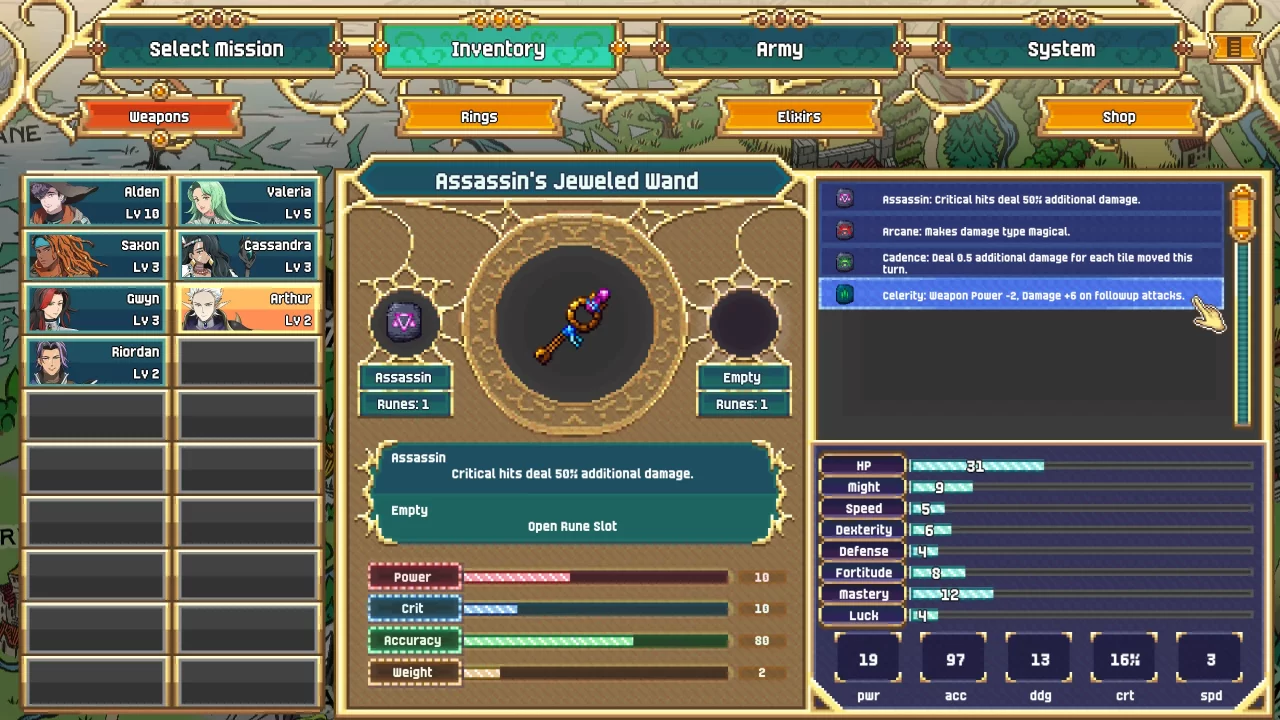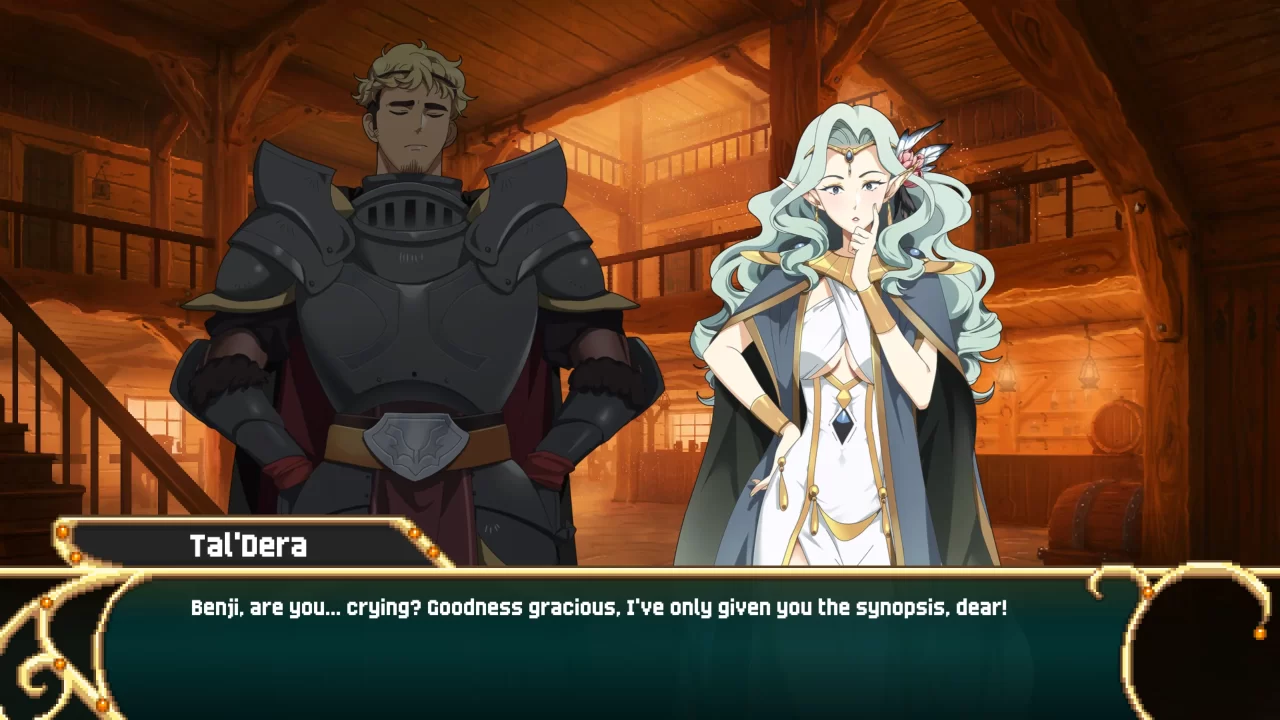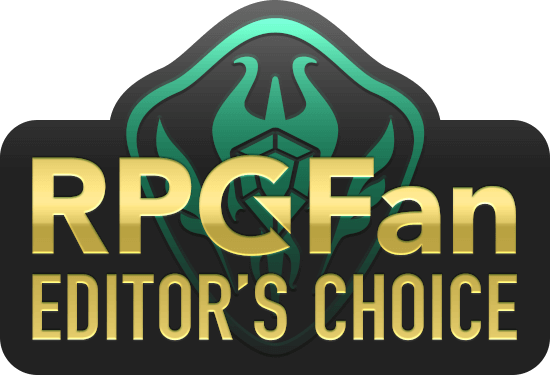Several years have passed since the Empyrean War. The protagonist of the first Dark Deity, Irving, has certainly kept himself busy. He’s now Grandmaster of the Order of Eternals, a peacekeeping force in the land of Verroa assisting those in need while remaining staunchly neutral to the politics of the surrounding countries. On top of this, he’s a father to three adult children: leader and “heir apparent” Gwyn, joking supporter Riordan, and the sensitive Arthur searching for clues to his origins outside his adopted family. The three embark on a mission to reclaim a magical artifact in a nearby country, inadvertently embroiling the Order in an evil empire’s invasion plans. Can they restore peace to the people of Verroa, even with increasingly complex and painful decisions? I was impressed with the first Dark Deity, an indie SRPG paying obvious homage to Fire Emblem, so naturally, I have high hopes for its sequel. I’m happy to say that Dark Deity 2 improves upon its predecessor’s gameplay mechanics while also having an arguably stronger narrative. It makes for a polished SRPG experience, though a few weaknesses poke through its defenses.
Dark Deity 2 opens with various difficulty levels and modes of play to help tailor combat to your preferences. The versatility is much appreciated, allowing experimentation beyond story replayability. Fights occur when your squad of party members moves across a battlefield grid, engaging in combat once they come into contact with an enemy unit. You can also use a character’s unique abilities outside of combat to either boost statuses, heal, or do damage outside unit combat. Those who played the first Dark Deity (or SRPGs modeled after FE) should quickly get the hang of combat, though there are helpful tutorials in the beginning stages, should you need them.
During a chapter fight, you clear the stage by accomplishing a primary objective. There are various objectives, so you’re not always seeing something like “defeat the boss.” Side objectives also exist and net useful item rewards if you successfully carry them out alongside the main objective, such as rescuing civilians or putting out fires. You must strategize effectively to successfully get through stages, particularly if trying to clear all side objectives or get all treasure chests on a map since there’s a turn limit in fights, and you must keep Gwyn alive. I found fights to be rather polished affairs that kept me on my toes, especially with keeping under the turn limit to avoid automatic game overs. However, I imagine those more familiar with SRPG mechanics might enjoy raising the difficulty level to ensure a challenge. You can change the difficulty settings at any time. Like in the first game, injuries that negatively affect a stat occur following a character’s defeat in combat instead of permadeath. Unlike the original Dark Deity, however, these injuries only last for one chapter instead of an entire playthrough. Sometimes, stages also have puzzle switches to use as you advance your units.
Outside combat, there are several ways to customize and strengthen your forces. Depending on their class, you equip weapons that have two rune slots that provide opportunities for more customization and different status boosts. Removing a rune once it is fitted costs money, so it’s good to ponder which ones you want to use. You also find status-boosting elixirs that raise a character’s stats permanently. You can use specific collected resources to craft rings, supplying various statuses and ability boosts when characters equip them.
You can also use materials collected during fights or from the shop menu to level up multiple attributes of character and job class abilities, such as increasing the range of AoE moves or decreasing the MP cost of a spell. You can respec these modifications even if you max them out, again allowing for creative experimentation with combat. Characters have two tiers of four job classes each, gaining access to each tier after raising character levels to a certain point and acquiring a unique item. The level of character customization, even outside of combat, is pretty robust. However, the menu navigation for the weapons, runes, and ring-equipping portions can be difficult, thanks to the small text and UI.
Each party member, with one noticeable exception later on, has four other characters they can develop strong rapport with outside the main story, often giving status and item rewards for strengthening their bond. Staying within the range of a potential bond character during combat fills the bond leveling gauge. I managed to max out most of the bonds in one playthrough, though I stumbled upon a glitch that prevented me from maxing out two. Hopefully, that gets patched soon.
Suppose you attempt a playthrough of only Dark Deity 2’s thirty story chapters. I imagine battles might be challenging in that case, but the game provides a handful of training battles you pay gold to initiate. These training battles can help strengthen and level up characters. I found them helpful in keeping my party on equal levels with one another as well as in raising bond levels. However, there isn’t a lot of variety when it comes to the training stages, so it can get repetitive if you rely on them. As you advance, you also unlock challenge fights. True to their name, you can only do these optional challenge fights once and they usually have more demanding objectives or only allow for a smaller number of max squad numbers.
From a plot stance, I’d argue that Dark Deity 2 builds upon the first game’s world-building and characters to significant effect and, therefore, has a more personal and stronger storyline. There’s even a degree of choice in your plot approach that affects battle stages and alters some story scenes, adding more replayability into the mix. I wouldn’t say it’s vital to play the first game to fully enjoy this one, as I think it stands well enough on its own, but I do think a quick playthrough of Dark Deity allows you to appreciate characters such as Irving and Alden more. It’s a great writing technique to show that heroes can be just as human and prone to mistakes/regrets as the rest of us, which is the takeaway from Irving’s character arc here. Obviously, he cares greatly for his three children, but he has strained relationships with all of them due to how he raised them.
Gwyn is an excellent new main character, full of doubt over her role as Irving’s heir but trying her best even as she nears the breaking point. Riordan has a lot of conflicting feelings towards his dad but wants to be there for his siblings, whom he views as destined for greatness. Arthur is a mystery even to himself, and that sense of being “othered” from his family torments him as he tries his best to understand his dad and support Gwyn and Riordan. They’re a relatable and wonderfully written trio of characters whose familial bond always shows through.
Likewise, returning powerhouse mage Alden is their supporting uncle, torn between his apparent love for his niece and nephews and his conflicting feelings about how Irving and their mother raised them. He’s phenomenally written, too, becoming one of my standouts in the cast, which is saying something since I honestly didn’t think much of him beyond being the “kid character” in the first game. This sequel, which addresses how his upbringing as a child soldier impacted his growing up, is also fascinating. All of the party characters are either quirky or have interesting backstories and well-developed personalities (often a combo of all three!) that make them intriguing, especially as they interact with other characters and show more of their personalities and relationship dynamics.
That said, as much as I love the bond dialogues, there’s one noticeable weakness: they’re optional. I love the character development and world-building through the bonds, but hiding those scenes unless you actively seek them out is a disservice. I wish Dark Deity 2 could somehow include many of the bond scenes in the main story. Take spunky Valeria as an example: I love the surprising reveal about her connection to a particular general in the main plot, and seeing their bonds together only makes their later main story scenes all the more heartwarming. However, she also has a bond with another character that, if I hadn’t maxed out their bond beforehand, would’ve made later main plot reveals seem like they came out of left field. It’s a shame that they feel so separate, as I genuinely think the bonds add much more depth to the plot.
Visually, I admit to not being the biggest fan of Dark Deity 2’s UI, especially the font. It clashes with the detailed VN-styled backgrounds and beautifully detailed character art in story scenes. It can also be hard to read, especially when cramming a large amount of text onto the screen. The pixelwork in the game is colorful and nicely detailed, though I sometimes notice a visual discrepancy with the pixel outfit colors in story scenes compared to the ones in battle, which is a bit bizarre. The scriptwork is mainly excellent, though a few typographical errors popped up. The English voice acting is truly above and beyond in Dark Deity 2. I was pleasantly surprised at how emotive and passionate the performances got. I enjoy how much of the admittedly large script is voice-acted, which makes not having voice-acted bond scenes somewhat disappointing. Props especially go to Elizabeth Maxwell as Gwyn, along with the voice actors for Alden and the diplomatic-minded Laurai, but everyone does a phenomenal job in their character roles. The game’s soundtrack is also quite fitting and helps set the stage for the tense, fantasy-themed fights.
Overall, I came away from Dark Deity 2 impressed. As far as it is a sequel, it’s an improvement from the original Dark Deity in many ways, which is saying something since I enjoyed that title, too! It’s a solid indie SRPG offering much replayability and player experimentation. I wouldn’t oppose a third game in this series, especially if it keeps this positive momentum. Instead of being viewed as just a Fire Emblem homage, Dark Deity 2 proves that it’s a labor of love with its own merit.






